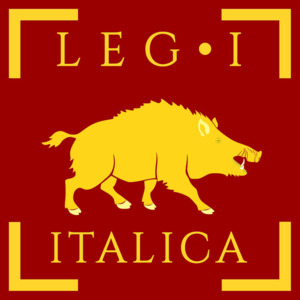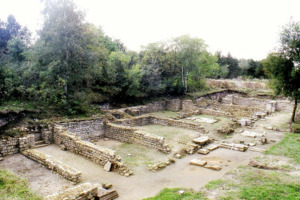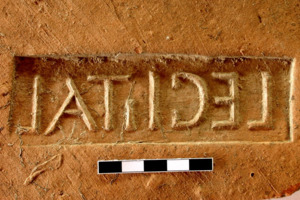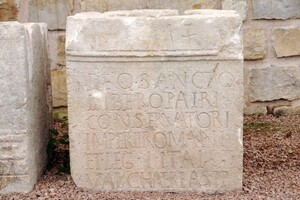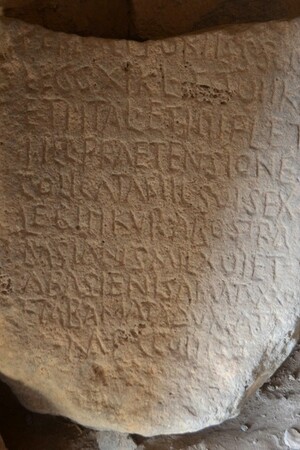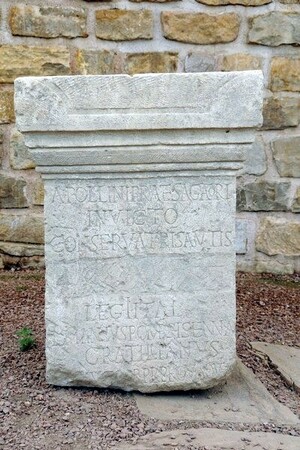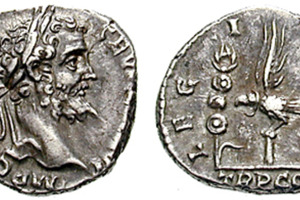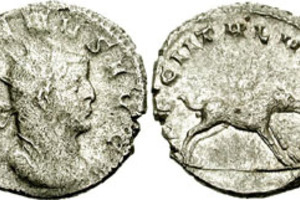Roman Legion - Legio I Italica
Legio I Italica (First Italian Legion) was a Roman legion created in September 66 or 67 AD by Emperor Nero (ruled from 54 to 68 AD) for the purpose of participating in the emperor's future campaign in Armenia and other eastern lands.
Legion name: Legio I Italica (First Italian Legion)
Dates of existence: From September 66/67 AD to the mid-5th century, after which it was transformed into comitatenses.
Logo: Boar, bull
Nickname: Antoniniana (Antonine), Severiana (Severan), Gordiana (Gordian), Pia Fidelis (Pious and Loyal)
Battle Path
- Legio I Italica (First Italian Legion) was created in September 66 or 67 AD by Emperor Nero for the purpose of participating in the emperor's future campaign in Armenia and other eastern lands. While the legion was being transported to the east in early 68 AD, the governor of Lugdunensis Gaul, Gaius Julius Vindex, revolted, and the legion was redirected to Gaul in March or April 68 AD. By the time Legio I Italica arrived at the scene of action in spring 68 AD, the rebellion had been suppressed, and Galba had become the new emperor in the summer of 68 AD, who moved the legion to Lugdunum (modern-day Lyon, France).
- In early 69 AD, Legio I Italica supported the new claimant to the imperial purple, the governor of Lower Germany, Vitellius, and joined his army. The legion received its baptism of fire at the First Battle of Bedriacum (April 14, 69 AD), where Vitellius' troops defeated the forces of Otho, who had overthrown Galba by that time. Later, Legio I Italica participated in the Second Battle of Bedriacum (also known as the Battle of Cremona) in October 69 AD, where Vitellius' forces were defeated by Vespasian, a new claimant to the imperial purple, a general from the East. In December 69 AD, Vespasian's troops entered Rome, making Vespasian the emperor, and Vitellius was killed. The new emperor directed Legio I Italica to Moesia, where it was stationed at Novae (modern-day Svishtov, Bulgaria).
- In Moesia, the legion, along with other Roman forces, suffered a defeat from the Sarmatian tribes that invaded Moesia in the winter of 69-70 AD. In 70 AD, the new governor of Moesia restored order and replenished the battered Legio I Italica. Moesia was the region between the Lower Danube and the Balkan Mountains.
- In Novae, Legio I Italica remained based until the mid-5th century, although vexillations of this legion were deployed throughout the Roman Empire. Traces of Legio I Italica vexillations are found in the 1st century in Crimea (in Chersonesus) and in Dacia (a vexillation of the legion participated in the Battle of Tapae in 88 AD). During the reign of Emperor Trajan (98-117 AD), veterans of Legio I Italica were settled in the newly founded colonies of Eska and Celea (modern-day Korybia, Romania), and in 98 AD, the legion's old base in Novae was rebuilt. Vexillations of the legion took part in the Dacian Wars (101-106 AD) and Trajan's Parthian campaign (114-117 AD). For the next 50 years, little is known about the legion's activities. It is suggested by found altars that vexillations of the legion were deployed by Emperor Hadrian in Delphi (there is an inscription dated to 125 AD) and Judea to suppress the Bar-Kokhba revolt.
- Under Emperor Antoninus Pius, between 139 and 142 AD, parts of Legio I Italica built the Antonine Wall between Edinburgh and Glasgow. There is a suggestion, based on an unclear inscription, that parts of the legion participated in suppressing the Moorish revolt in North Africa under Antoninus Pius. Under Emperor Marcus Aurelius, the legion took part in the Marcomannic Wars (166-180 AD). Possibly, for their bravery, the Legio II and Legio III created during this time were named Italica. Besides wars, the legion continued guarding the Danube border. After the division of Moesia into Upper and Lower, the forces of Legio I Italica belonged to the Lower Moesian army.
- After 168 AD, vexillations of the legion occupied the important fortress of Capidava, guarding the Danube crossing in Lower Moesia. Found bricks of the legion's temple with its stamp near the Danube fleet station at the Dinegetia fortress confirm that Legio I Italica had its own ships for patrolling the Danube and other tasks. In the 2nd and 3rd centuries, vexillations from Legio I Italica and Legio XI Claudia were stationed in the city of Montanensium (modern-day Montana, Bulgaria) to protect local silver mines and capture animals for circus games. Under the Severan dynasty, the legion was actively building on its base in Novae. In 193 AD, when the governor of Pannonia, Septimius Severus, claimed the imperial purple, the legionaries of Legio I Italica, led by their legate Lucius Marius Maximus Perpetuus Aurelianus, supported him. The legion fought for Severus first against Pescennius Niger in the East, besieging Byzantium, and then in 197 AD against Clodius Albinus at the Battle of Lugdunum.
- There is a version that Legio I Italica participated in Severus' Parthian campaigns in 195 AD and 197-198 AD. In 205 AD, Legio I Italica received the honorable nickname Antoniniana ("Antonine"). Under Septimius Severus' son, Emperor Caracalla, who expanded Dacia's southern border by 50 kilometers, the defensive network of Limes Transalutanus was built, starting very close to Novae, suggesting the involvement of Legio I Italica legionaries in its construction.
- Under Emperor Alexander Severus, the legion received the honorable nickname Severiana ("Severan"). Also, a large vexillation of the legion was stationed in the Dalmatian city of Salona (modern-day Split, Croatia). Between 238 and 244 AD, the legion received another nickname, Gordiana ("Gordian"), in honor of Emperor Gordian III (ruled from 238 to 244 AD), whom the legion supported in his struggles. To commemorate this, a statue of Emperor Gordian III was even erected at the legion's base in the city of Novae. A vexillation of Legio I Italica, along with vexillations from other legions, participated in road construction in Jordan, as evidenced by a stone inscription found there (the inscription from Qasr al-Azraq). Around 250 AD, the legion's base, Novae, withstood a siege by the Ostrogoths despite part of the camp being destroyed by the enemy.
- Under Emperor Gallienus, Legio I Italica received the honorable nickname Pia Fidelis ("Pious and Loyal") for its loyalty to the emperor, as evidenced by inscriptions on coins of that time. At the end of the 3rd century, Legio I Italica is mentioned for an unknown reason as the "Moesian Legion." Almost all recruits to the legion during this period came from Thrace. Under Emperor Diocletian, a vexillation of the legion was part of the field army of the diocese.
- Around 297, the Legio I Italica vexillation, along with other troops, participated in the suppression of an uprising in Egypt. Later, she was transferred to Arabia Petraea, where she built a road that connected the fortresses of Bosra, Basianid, Amata and Dumata. Arabia Petraea was a Roman border province that existed from the second to the seventh centuries. This term also referred to one of the three parts of the Arabian Peninsula (the other two are Arabia Magna and Arabia Felix).
- Around 300 AD, the Vexillatio Legio I Italica, together with the Vexillatio Legio II Herculia under the command of Maximian, left a commemorative inscription in honor of the tetrarchs in Chersonesos.
- During the reign of Emperor Constantine the Great, part of the Legio I Italica was known as Primani.
- Around 316-317, the Novach camp was partially destroyed. It was also partially inhabited by the civilian population.
- At the beginning of the fifth century, according to the Notitia Dognitatum, around 400, the Legio I Italica was still guarding the Danube, but was divided into two parts: one of which was under the command of the Dux of Moesia. The Legion prefect and the Border prefect were stationed with their units in Novy, while the other border prefect was located 100 kilometers downstream of the Danube in Sextagint Priest (modern city of Ruse or Ruschuk, Bulgaria). The second part of the legion, in the status of pseudo-komitatens, was under the authority of the military Master of the East, while the Palatine Legion was under the direction of the master of the court troops.
Related topics
List of Roman Legions, The Roman Empire, Legion, Legionnaires, Legio XI Claudia, Komitatens, Marcus Ulpius Nerva Trajan, Dux, Notitia Dignitatum
Literature
1. Kanya River. A brief history of the various Roman legions.
2. Emil Ritterling. Paulys Realencyclopädie der classischen Altertumswissenschaft. Legio (I Italica). Band XII,2. — Stuttgart, 1925. — 1407—1417 p.
3. Julian Bennett. Trajan. Optimus Princeps. — Routledge, 1997.
4. Gabriele Wesch-Klein. Soziale Aspekte des römischen Heerwesens in der Kaiserzeit. — Stuttgart: Franz Steiner Verlag, 1998.
5. Marietta Horster. Novae. In: Reallexikon der Germanischen Altertumskunde (RGA). 2. Auflage. Band 21. — Berlin/New York: Walter de Gruyter, 2002.
6. M. Absil, "Legion I Italica", in: Yann Le Boek, Les legions de Rome sous le Haut-Empire (2000, Lyon) 228-238.
7. A. B. Bernatsky and N. Sharankov, "A hitherto unknown aspect of the military activities of the Italian Legion I in the light of the recently discovered pedestal with a Greek inscription from Nova" in Archaeologia Bulgarica 22/3 (2018) 1-19.
8. MP Speidel and J. Reynolds, " Veteran of the Legio I Parthica of Carian Aphrodisias ", in Epigraphica Anatolica 5 (1985) 31-35.
